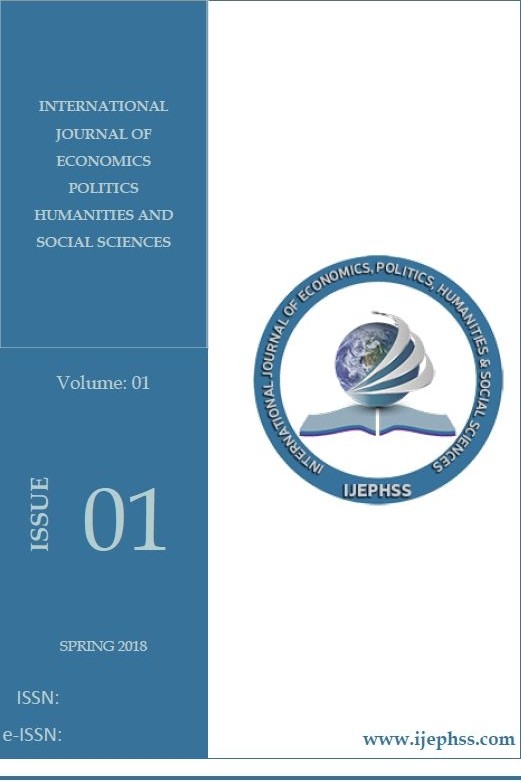BORSA ENDEKS GETİRİSİNİN YATIRIM FONLARI PORTFÖYÜNDEKİ PAY SENEDİ ORANINA ETKİSİ: NEDENSELLİK ANALİZİ
Tasarruf sahiplerinin birikimlerini daha profesyonel şekilde sermaye piyasalarında değerlendirmelerini sağlayan yatırım fonları, inançlı mülkiyet esasına göre ve tüzüğünde belirtilen varlıklardan oluşan portföylerin işletilmesi için kurulan, tüzel kişiliği olmayan mal varlıklarıdır. Daha önceden portföylerindeki hisse senedi ağırlığına bağlı olarak A ve B tipi şeklinde sınıflandırılan fonlar, 2013 yılında yayımlanan yeni tebliğle birlikte Şemsiye Fon adı altında altsınıflara ayrılmıştır. Bu çalışmada, yatırım fonlarının türüne bakılmaksızın, toplam portföylerindeki hisse senedi ağırlığı ile borsa endeksi arasındaki nedensellik ilişkisi incelenmektedir. Burada temel amaç, borsa endeksindeki hareketlerin, yatırım fonlarının portföy dağılımında etkisinin olup olmadığını, aralarındaki simetrik ve asimetrik nedensellik ilişkisi çerçevesinde incelemektir. Çalışma, Ocak 2005 - Haziran 2019 dönemine ait 174 aylık veriyi kapsamaktadır. Veri setini yatırım fonlarının portföylerindeki hisse senedi oranı ile BİST-100 endeksi aylık ortalama değerinden oluşan zaman serileri oluşturmaktadır. Analiz yöntemi olarak simetrik ve asimetrik nedensellik testleri uygulanmıştır. Elde edilen bulgular portföy dağılımındaki pay senedi oranında borsa endeksindeki hareketlerle nedensellik ilişkisi olmadığını ortaya koymaktadır.
Anahtar Kelimeler:
Yatırım Fonu, Borsa İstanbul, Portföy Çeşitlendirmesi
THE INFLUENCE OF STOCK MARKET RETURNS ON THE RATIO OF EQUITY IN MUTUAL FUNDS PORTFOLIO: CAUSALITY ANALYSIS
Mutual funds which enable savers to evaluate their savings in the capital markets in a more professional way, are established on the basis of fiduciary property and for the operation of portfolios consisting of the assets specified in the regulation. In Turkey, funds used to be classified as type A and B based on the stock weight in their portfolios. But they have been subdivided under the name of Umbrella Fund with the new communiqué published in 2013. This study analyzes the causality relationship between the stock weight in the total portfolios of funds and the stock market index returns. The main objective is to examine whether the movements in the index have an effect on the portfolio allocation of funds within the symmetric and asymmetric causalities. The study includes 174 monthly data for the period of January 2005 - June 2019. The data set consists of the stock ratio of mutual funds portfolios and the logharitm of monthly average value of BIST-100 index. Symmetric and asymmetric causality tests were used as the analysis method. The findings indicate that there is no causal relationship between the movements in the stock market index and the share ratio in the portfolio distribution.
Keywords:
Mutual Funds, Borsa Istanbul, Portfolio Diversification,
___
- Alexander, G. J., & Stover, R. D. (1980). Consistency of mutual fund performance during varying market conditions. Journal of Economics and Business, 32(3), 219-226.
- Bhargava, A. (1986). On the theory of testing for unit roots in observed time series. The Review of Economic Studies, 53(3), 369-384.
- Bogle, J.C. (2005). The mutual fund ındustry 60 years later: for better or worse?, Financial Analysts Journal, 61:1, 15-24,
- Chen, H., Jegadeesh, N., Wermers, R. (2000). The value of active mutual fund management: an examination of the stockholdings and trades of fund managers. Journal of Financial and Quantitative Analysis, 35, 343–368.
- Dickey, D. A. & Fuller, W. A. (1981). Likelihood ratio statistics for autoregressive time series with a unit root. Econometrica: Journal of the Econometric Society, 49(4), 1057-1072.
- Edelen, R. M., Ince, O. S., & Kadlec, G. B. (2016). Institutional investors and stock return anomalies. Journal of Financial Economics, 119(3), 472–488.
- Fabozzi, F. J., & Francis, J. C. (1979). Mutual fund systematic risk for bull and bear markets: an empirical examination. The Journal of Finance, 34(5), 1243-1250.
- Gompers, P. A., & Metrick, A. (2001). Institutional Investors and Equity Prices. The Quarterly Journal of Economics, 116(1), 229–259.
- Granger, C. W. (1969). Investigating causal relations by econometric models and cross-spectral methods. Econometrica: Journal of the Econometric Society, 424-438.
- Granger C. W., Yoon, G. (2002). Hidden cointegration. Department of Economics Working Paper. University of California, San Diego
- Grinblatt, M., Titman, S., & Wermers, R. (1995). Momentum Investment Strategies, Portfolio Performance, and Herding: A Study of Mutual Fund Behavior. The American Economic Review,85(5), 1088-1105
- Hatemi-J, A. (2012). Asymmetric causality tests with an application. Empirical Analysis, 43(1): 447-456
- Matriks, Matriks Veri Terminali, 05.11.2019
- Ng, S. & Perron, P. (2001). Lag length selection and the construction of unit root tests with good size and power, Econometrica, 69(6), 1519-1554.
- Phillips, P. CB. (1987). Time series regression with a unit root. Econometrica, 55(2), 277-301.
- Phillips, P. CB & Perron, P. (1988). Testing for a unit root in time series regression. Biometrika, 75(2), 335-346.
- Portföy Yönetim Şirketleri ve Bu Şirketlerin Faaliyetlerine İlişkin Esaslar Tebliği, SPKn, III-55.1, http://mevzuat.spk.gov.tr/, 15.08.2019
- SPK Aylık İstatistik Bültenleri, https://spk.gov.tr/SiteApps/Yayin/AylikIstatistikBultenleri, 10.10.2019
- SPK, http://spk.gov.tr, 10.10.2019
- TCMB Elektronik Veri Dağıtım Sistemi, http://evds.tcmb.gov.tr, 10.10.2019
- Toda, H. Y., & Yamamoto, T. (1995). Statistical inference in vector autoregressions with possibly integrated processes. Journal of econometrics, 66(1-2), 225-250.
- Treynor, J., & Mazuy, K. (1966). Can mutual funds outguess the market. Harvard Business Review, 44(4), 131-136.
- Yatırım Fonlarına İlişkin Esaslar Teblği, SPKn, III-52.1, http://mevzuat.spk.gov.tr/, 15.08.2019
- Başlangıç: 2018
- Yayıncı: Onur OĞUZ
Sayıdaki Diğer Makaleler
LOJİSTİK TEDARİKÇİ SEÇİMİNDE AKSİYOMATİK TASARIM TEKNİĞİ UYGULAMASI
IRAK- TÜRKİYE ENERJİ İLİŞKİLERİNİN BÖLGENİN EKONOMİK GÜVENLİĞİNE ETKİLERİ
2008 SONRASI TCMB FAİZ KARARLARININ MAKROEKONOMİK ETKİLERİNİN ANALİZİ
SİYAH EKONOMİK GÜÇLENDİRMENİN YAPISAL ENGELLEYİCİLERİ VE YENİDEN TASARLANMASI: GÜNEY AFRİKA ÖRNEĞİ
